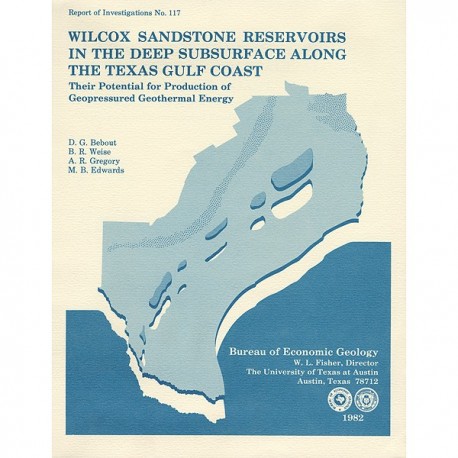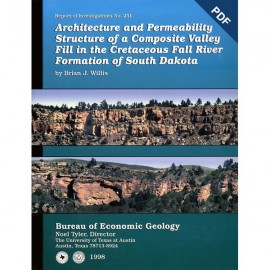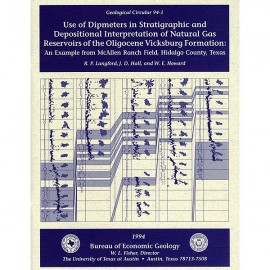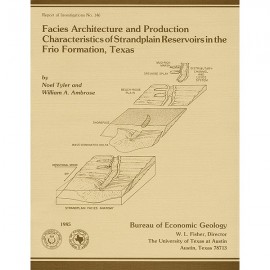Reports of Investigations
-
Books & Reports
- Reports of Investigations
- Guidebooks
- Udden Series
- Geological Circulars
- Down To Earth
- Atlases of Major Oil and Gas Reservoirs
- Texas Memorial Museum Publications
- Environmental Geologic Atlas of the Texas Coastal Zone
- Mineral Resource Circulars
- Other Reports
- Seminars and Workshops
- Handbooks
- Submerged Lands of Texas
- Symposia
- Annual Reports
- Open File Reports
-
Maps & Cross Sections
- Thematic Maps
- Miscellaneous Maps, Charts & Sections
- Geologic Atlas of Texas
- STATEMAP Project Maps
- Geologic Quadrangle Maps
- Cross Sections
- Highway Geology Map
- Energy and Mineral Resource Maps
- Shoreline Change and Other Posters
- Wilcox Group, East Texas, Geological / Hydrological Folios
- Bouguer Gravity Atlas of Texas
- River Basin Regional Studies
- Featured Maps
- Posters
- Teachers & the Public
-
Geological Society Publications
- Gulf Coast Association of Geological Societies
- Alabama Geological Society
- Austin Geological Society
- Corpus Christi Geological Society
- Houston Geological Society
- Lafayette Geological Society
- Mississippi Geological Society
- New Orleans Geological Society
- South Texas Geological Society
- GCS SEPM Publications
- Historic BEG & UT Series
Wilcox Sandstone Reservoirs in the Deep Subsurface along the Texas Gulf Coast
RI0117
Wilcox Sandstone Reservoirs in the Deep Subsurface along the Texas Gulf Coast: Their Potential for Production of Geopressured Geothermal Energy, by D. G. Bebout, B. R. Weise, A. R. Gregory, and M. B. Edwards. 125 p., 135 figs., 4 tables, 2 appendices, 1982. ISSN: 0082335X:Print. Print Version.
A free, digital version of this publication can be found on: Texas ScholarWorks
RI0117. Wilcox Sandstone Reservoirs in the Deep Subsurface along the Texas Gulf Coast: Their Potential for Production of Geopressured Geothermal Energy, by D. G. Bebout, B. R. Weise, A. R. Gregory, and M. B. Edwards. 125 p., 135 figs., 4 tables, 2 appendices, 1982. ISSN: 0082335X:Print.
To purchase this product as a downloadable PDF, please order RI0117D.
ABSTRACT
Regional studies of the lower Eocene Wilcox Group in Texas were conducted to assess the potential for producing heat energy and solution methane from geopressured fluids in the deep-subsurface growth-faulted zone. However, in addition to assembling the necessary data for the geopressured geothermal project, funded by the U.S. Department of Energy, this study has provided regional information of significance to exploration for other resources such as lignite, uranium, oil, and gas. Because the focus of this study was on the geopressured section, emphasis was placed on correlating and mapping those sandstones and shales occurring deeper than about 10,000 ft.
The Wilcox and Midway Groups comprise the oldest thick sandstone/shale sequence of the Tertiary of the Gulf Coast. The Wilcox crops out in a band 10 to 20 mi wide located 100 to 200 mi inland from the present-day coastline. The Wilcox sandstones and shales in the outcrop and updip shallow subsurface were deposited primarily in fluvial environments; downdip in the deep subsurface, on the other hand, the Wilcox sediments were deposited in large deltaic systems, some of which were reworked into barrier-bar and strandplain systems. Growth faults developed within the deltaic systems, where they prograded basinward beyond the older, stable Lower Cretaceous shelf margin onto the less stable basinal muds.
Continued displacement along these faults during burial resulted in (1) entrapment of pore fluids within isolated sandstone and shale sequences and (2) buildup of pore pressure greater than hydrostatic pressure and development of geopressure. Regional electric log correlation markers made possible the subdivision of the Wilcox into lower, middle, and upper parts. The net-sandstone map of the lower Wilcox indicates a dominantly lobate pattern northeast from De Witt County to the Sabine River. Fisher and McGowen (1967) interpreted the lower Wilcox in that area to have been deposited in a high-constructive delta system, which they named the Rockdale Delta System. To the south, the lower Wilcox net-sandstone map indicates a narrow, elongate trend; Fisher and McGowen interpreted these sediments to have been deposited in strandplain and barrier-bar systems and named them the San Marcos Strandplain and Cotulla Barrier-Bar Systems.
The dominantly shale section of the middle Wilcox was deposited as a result of a marine transgression over the lower Wilcox. Thus, the shale is an offshore equivalent both of middle Wilcox sandstones far updip and of sandstones of the lower part of the upper Wilcox.
The net-sandstone map of the upper Wilcox indicates abrupt thickening along the Lower and MiddleTexas Gulf Coast, resulting from deposition contemporaneous with faulting in major deltaic systems. In contrast, along the Upper Texas Gulf Coast, abrupt downdip thickening does not occur, and these strata are not extensively growth faulted.
Information on subsurface pressures and pressure gradients was obtained from (1) bottom-hole shut-in pressure data from drill-stem tests, (2) shale resistivity data from electric logs, (3) mud weights from well log headings, and (4) shale transit times from sonic logs. The top of geopressure was picked at approximately the depth where a pressure gradient of 0.7 psi per foot occurs. This depth is considered the "operational" top of geopressure because it is somewhat higher pressure than the 0.465 psi per foot hydrostatic pressure gradient. The zone where pressure gradients are between 0.465 and 0.7 psi per foot is transitional and difficult to identify consistently. The resulting map indicates that the top of geopressure occurs between depths of 8,000 and 13,000 ft along the Wilcox trend; in general, the top of geopressure is deeper in high-sandstone areas and shallower in high-shale areas.
Formation temperatures, corrected to equilibrium values, were determined throughout the Wilcox trend to permit calculation of the amount of methane dissolved in the water. Knowledge of subsurface temperature is also essential in studying diagenesis of sandstone, dewatering of shale, and maturation of organic material and generation of hydrocarbons.
As a result of this regional study of the Wilcox Group, six geothermal fairways were identified--Zapata, Duval, Live Oak, De Witt, Colorado, and Harris. Thick sandstone units with formation temperatures greater than 300°F occur in all fairways; however, high porosity and permeability occur in only the De Witt Fairway (Cuero area), making it the only one having high potential for geopressured geothermal energy production.
Keywords: geopressure, geothermal, Wilcox Group, Midway Group, geothermal fairways, De Witt County, Duval County, Live Oak County, Colorado County, Harris County, Texas
Citation
Bebout, D. G., Weise, B. R., Gregory, A. R., and Edwards, M. B., 1982, Wilcox Sandstone Reservoirs in the Deep Subsurface along the Texas Gulf Coast: Their Potential for Production of Geopressured Geothermal Energy: The University of Texas at Austin, Bureau of Economic Geology, Report of Investigations No. 117, 125 p.






